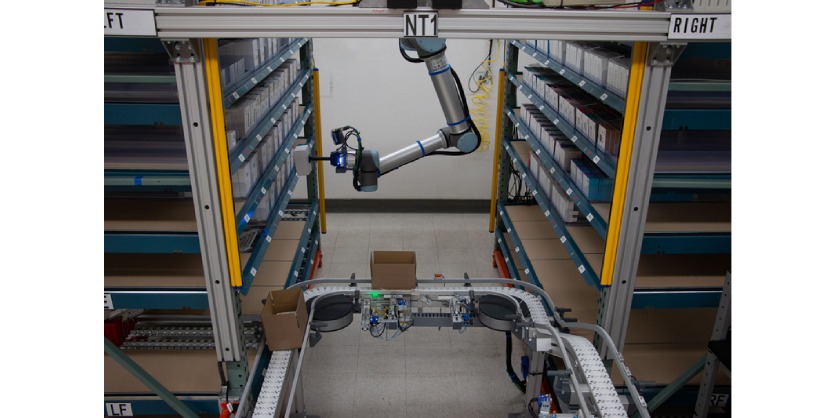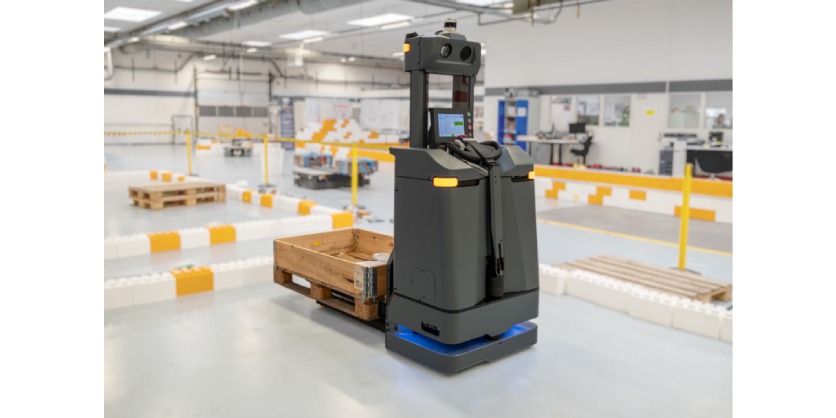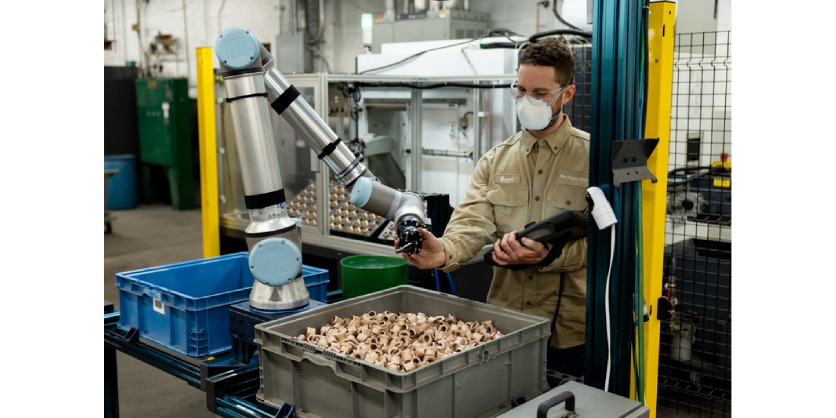Artificial Intelligence (AI) Integrates with Cobots and AMRs Making them Smarter

April 10, 2024
By Krystie Johnston
Robot technology is becoming increasingly accessible for companies of all sizes across a wide range of industries. Accelerated computing and the ever-evolving contribution of artificial intelligence or AI are transforming virtually everything – robots and robot technology included. Teradyne Robotics, a global leader in advanced automation solutions and parent company to Universal Robots (UR) and Mobile Industrial Robots (MiR), introduce their new AI-enabled collaborative robot arms and autonomous mobile robots.
Anders Billesø Beck, VP of Innovation and Strategy at Universal Robots, discusses the integration of AI into collaborative robots (cobots) and autonomous mobile robots or AMRs, and the benefits that AI can bring to robotic applications and the industries they serve.
Beck admits that many of the challenges faced in robotic applications stem from the fact that robots are not humans. Making applications reliable, despite variations in the environment or task, remains a complication for robots that he says can be aided with AI. If this is possible, there will be virtually no industry that will not benefit from it today. “What AI can do today, and will be doing more in the future, is to have that sort of human-scale capability of seeing things and even generating the behaviour of what it would take to grasp or react to whatever it sees.”

High-mix low volume manufacturing is one application that stands to benefit from AI-enabled robotics and is a great example of where this technology is going. Where a robot was once programmed to repeat the same motion and was incapable of doing anything beyond that, AI will enable a robotic arm to grasp objects of various shapes and sizes beyond what was programmed, learning as it goes and essentially teaching itself along the way.
Collaborative robots enabled with artificial intelligence will offer a more robust and reliable solution for many applications and be capable of managing variations in a more human-like way. For example, an assembly line with objects of varying size, texture, orientation, or weight requires the intelligence to differentiate these differences and react accordingly to each in turn. Generative AI, artificial intelligence that can create an output based on a set of data, independently, without being programmed to, is a promising solution. Beck sees the similarities between how large language models (LLMs) like ChatGPT create language generation and AI-enabled robots can be trained to “act” more human-like.
“Generative AI is really the place where we can start taking learnings of something that is already done once in the past, and generate solutions to problems that are similar. It doesn’t need to be identical, but similar. We have seen text generation, where text, sort of similar to text that has been written in the past, can be generated. There is no doubt we can see the same thing happening in robot programs and robot behaviours and mimic solutions to problems that have been seen before,” Beck says.
Training robots to be more human-like does not stop at cobots. Universal Robots’ sister company, Mobile Industrial Robots or MiR, is also leveraging AI to become more intelligent.
Where a cobot typically remains in a fixed location to work, autonomous mobile robots have the added challenge of having to perform a task (i.e. carry something, lift, or roll it) while navigating a constantly changing, dynamic environment. Therefore, AMR applications stand to benefit tremendously from AI. By becoming more intelligent, AMRs will be capable of navigating and solving challenges in a similar way that a person would.
“MiR just launched an AI-enabled pallet jack two days ago, and it was very well received in the world market. The unique thing about it is that it uses AL technology to detect the pallets. Everyone that has seen pallets in real-life manufacturing knows that a pallet is not just a pallet: the pallet can be broken, it can be dirty, or wrapped in foil. It can have stickers or paint on it. There are so many variations.”
Being able to distinguish between the differences is something that humans can do by nature. To accomplish this, a robot needs to be trained – and it needs to practice. This is where using AI in robotics can elevate various tasks and applications to new heights. With so many variations to a single pallet, it has been thus far impossible to automate pallet detection using traditional vision techniques. To accomplish this goal, the AMR must be able to “think” and “act” like a person.
“By feeding it [the AMR] with thousands of images of real-life pallets, it now detects pallets at high accuracy – even if it is wrapped in shrink wrap, or it is painted black with a big sticker on it – and this is a good example of problems that humans are pretty good at. All of us can see that it is a pallet, we can infer that, no matter how it is dressed. But that has been traditionally really difficult for computers and robots to do. And AI is a perfect technology to train that [ability]. This is making it much easier for manufacturers to actually have pallet transportation that works, no matter these varying conditions,” says Beck.

There are many more steps in the journey to have fully autonomous robotic applications across all industries – but the building blocks are there. The potential for cobots and AMRs and other robotic technologies to “feed” data to themselves and “learn” from their own input is there. Beck says the interesting part about this is that it makes the robot more human-like because it will try to improve itself.
“If you or I are struggling with something, we will practice a bit more under those exact conditions. It [learning] does not take an engineering effort; it takes a training effort instead. And I think practice is something that all of us can sort of relate to. There is no doubt we can use it [AI] for optimizing [a process], we can also use it for understanding variation and opportunities for improvement. It may not need to happen fully autonomous, all of it. But just having something built-in that can pinpoint that we are not running things optimally, or suggest what can be done better, will all be things that become possible when we add these kinds of technologies.”
Artificial intelligence is rapidly becoming part of the engineering toolbox for many companies and will open new applications in the years to come. AI-enabled robots, although still developing, offer immense opportunities for virtually every application and every industry. Beck says that he sees this technology being used beyond industry and gaining traction in service businesses as well. It will become an indispensable tool in every industry’s toolkit, and like a tool, one only needs to know how to use it, not how to make it, to benefit from its function.
When Beck speaks with his customers and discusses the market, he notices two trends working in favor of end-users who desire this technology but may not have the skills or knowledge behind it. One is that robotic automation is becoming more and more standardized. End users will be able to identify automation solutions more easily because their application will fall into somewhat standardized categories. Additionally, robotic automation is becoming much more approachable for end users, and it is easier to use today than ever before. The complexities inherent in the technology are embedded in the AI systems and is not something that the end customer needs to fully understand or design on their own.

Artificial intelligence and AI-enabled robotics will continue to evolve over time and develop more complete behaviours as they learn. Today’s examples paint a picture of a path that could have full end-to-end applications; however, there is still road ahead on this journey. Beck says there are many more steps to take before we reach a point where robots rival the intelligence of the experts we have around the world, but we will see AMRs and cobots getting smarter.
















